The Zig Zag Indicator is a renowned tool in the world of Forex trading, revered for its ability to pinpoint trend reversals and filter market noise effectively. By incorporating this indicator into a trading strategy, traders can enhance their decision-making process and potentially improve their trading outcomes.
In this article, we will dissect ten simplified strategies that leverage the power of the Zig Zag Indicator, offering insights into maximizing its potential and optimizing trading performance. Understanding these strategies can provide traders with a competitive edge in navigating the complexities of the Forex market and seizing profitable opportunities.
Zig Zag Indicator Explained
The Zig Zag indicator, a versatile tool in the realm of forex trading, serves as a robust mechanism for identifying crucial market turning points by connecting significant highs and lows.
This indicator effectively filters out minor price movements, focusing solely on substantial price changes essential for trend analysis within the forex market.
Traders find the Zig Zag indicator particularly useful due to its customizable settings, such as depth and deviation, enabling them to align the tool with their specific trading strategies and preferences.
When paired with other technical analysis tools like Fibonacci retracements and Elliott Wave Analysis, the Zig Zag indicator enhances traders' ability to confirm market trends, pinpoint optimal entry and exit points, and capitalize on price movements within well-defined trading channels.
Benefits of Using Zig Zag
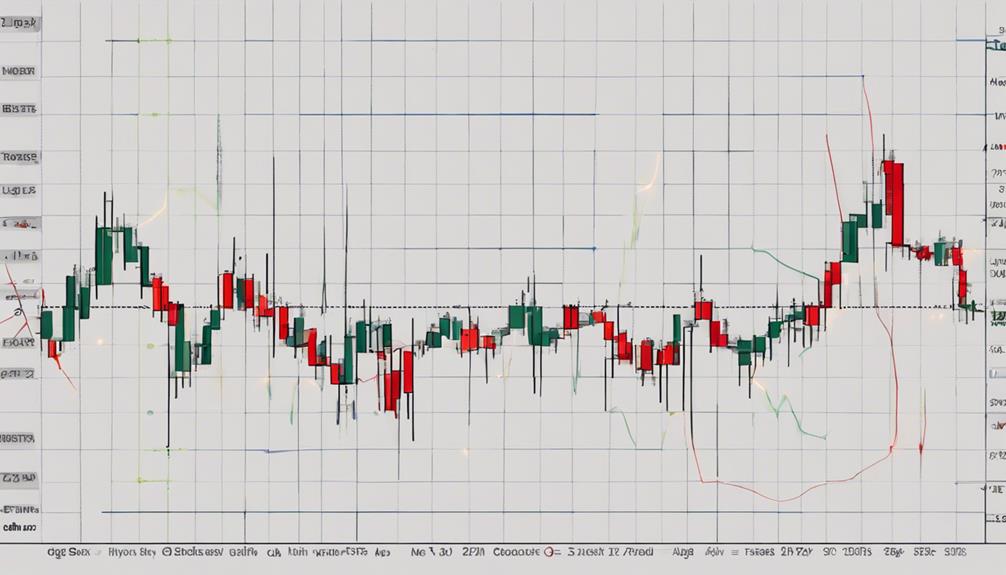
With its ability to filter out insignificant price fluctuations and highlight critical market turning points, the Zig Zag indicator offers forex traders a valuable tool for identifying major price reversals and establishing clear support and resistance levels.
The Zig Zag line created by this indicator connects significant swing highs and lows, typically deviating around 5%, providing traders with key levels to watch for potential trend changes. By focusing on these swing points, traders can better gauge the strength of a current trend and anticipate possible shifts in market direction.
Moreover, the Zig Zag indicator aids in confirming trend changes, helping traders make informed decisions about entry and exit points. When used in conjunction with other technical analysis tools, such as moving averages or Fibonacci retracements, the Zig Zag indicator can enhance the accuracy of trend analysis and improve overall trading strategies.
In essence, the Zig Zag indicator simplifies the process of identifying crucial price levels and market trends, making it a valuable asset for traders seeking to navigate the forex market effectively.
How to Set Up Zig Zag
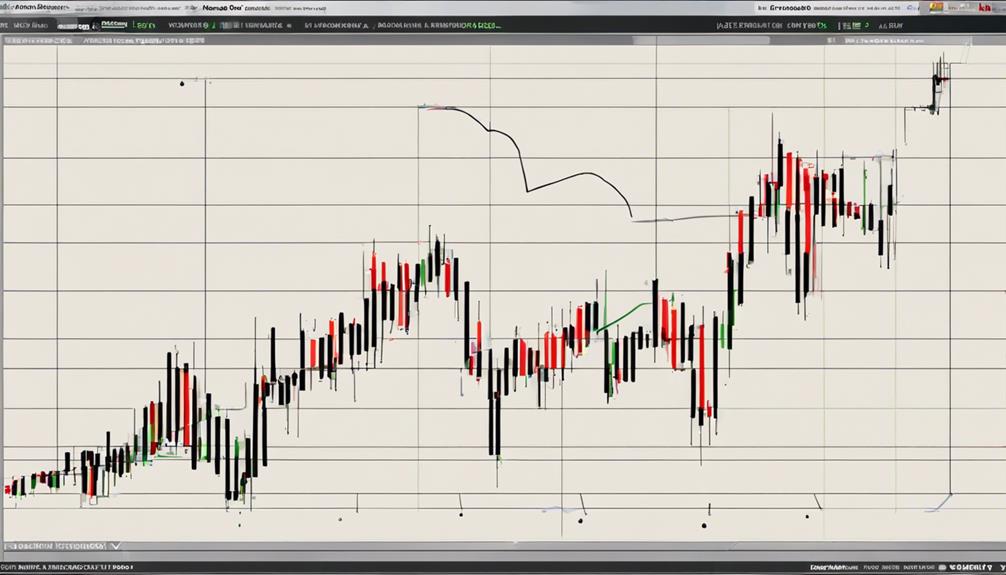
The process of setting up the Zig Zag indicator involves defining parameters such as depth and deviation to fine-tune its performance.
Traders must carefully select the timeframe that aligns with their trading goals and strategies.
Additionally, customization options allow for a personalized approach that suits individual preferences and risk tolerance levels.
Zig Zag Parameters
Implementing precise Zig Zag indicator parameters is essential for effectively identifying trends in Forex trading. The parameters include Depth, which determines the minimum number of bars between high and low points, Deviation, setting the minimum price change needed to form a new peak or trough, and Backstep, controlling the minimum number of bars before a high or low can be altered.
Setting up these Zig Zag parameters accurately is crucial as it directly impacts the indicator's ability to filter out minor price movements and highlight significant price reversals. By adjusting these parameters according to the specific characteristics of the market being analyzed, traders can enhance their trend identification capabilities and make more informed trading decisions in the dynamic Forex market.
Timeframe Selection
To effectively set up the Zig Zag indicator, traders must carefully consider the appropriate timeframe selection based on their individual trading preferences and objectives. The choice of timeframe is essential as it aligns the Zig Zag Indicator with the trader's specific trading style and goals.
For instance, shorter timeframes like the 1-hour chart are ideal for day traders seeking quick trading opportunities due to the more frequent price fluctuations. On the other hand, longer timeframes such as daily charts suit swing traders focusing on capturing significant price movements over a more extended period.
Customization Options
Customization options for the Zig Zag indicator in Forex involve fine-tuning parameters like depth, deviation, and backstep to align with traders' specific strategies and objectives. Traders can adjust the default values to customize the indicator according to their trading preferences:
- Depth: Determines the minimum number of pips or percentage points between consecutive peaks and troughs.
- Deviation: Sets the percentage change required for the indicator to plot a new high or low.
- Backstep: Defines the number of periods that must pass before a new high or low can be established.
- Sensitivity: By adjusting these parameters, traders can control the sensitivity of the Zig Zag indicator to market fluctuations.
Identifying Trends With Zig Zag

The Zig Zag indicator is a valuable tool for identifying trends in the Forex market. It provides traders with crucial insights into potential shifts in market direction. By offering trend reversal signals and the ability to customize parameters, such as depth and deviation, traders can optimize their trend analysis to suit their specific trading strategies.
This functionality allows traders to make informed decisions on entry and exit points, enhancing their overall trading performance.
Trend Reversal Signals
By connecting significant price highs and lows, the Zig Zag Indicator effectively identifies trend reversal signals in the Forex market. This tool filters out minor price movements to focus on key trend changes, offering traders a clearer view of market direction.
Understanding trend reversal signals with the Zig Zag Indicator is crucial for making informed trading decisions and timing entries and exits in the Forex market. Utilizing the Zig Zag lines allows traders to visually confirm the beginning or end of trends, aiding in trend analysis.
- The Zig Zag Indicator connects significant price highs and lows.
- It filters out minor price movements to focus on key trend changes.
- Traders can make informed decisions based on identified trend reversal signals.
- Visual confirmation of trend beginnings or endings is provided by plotting Zig Zag lines.
Setting Optimal Parameters
To enhance trend identification accuracy in Forex trading, establishing optimal parameters for the Zig Zag indicator is essential for filtering out insignificant price fluctuations and emphasizing meaningful market movements.
Optimal parameters typically include a Depth setting of 12, a Deviation setting of 5%, and a Backstep setting of 3.
The Depth parameter determines the significance required for a price movement to create a new swing high or low, while the Deviation parameter controls the percentage change necessary for a swing high or low to form, reducing noise in trend analysis.
These settings assist in fine-tuning the Zig Zag indicator to effectively identify trends and potential reversal points, ensuring a focus on significant market movements and enhancing trading decisions in the Forex market.
Entry and Exit Points With Zig Zag
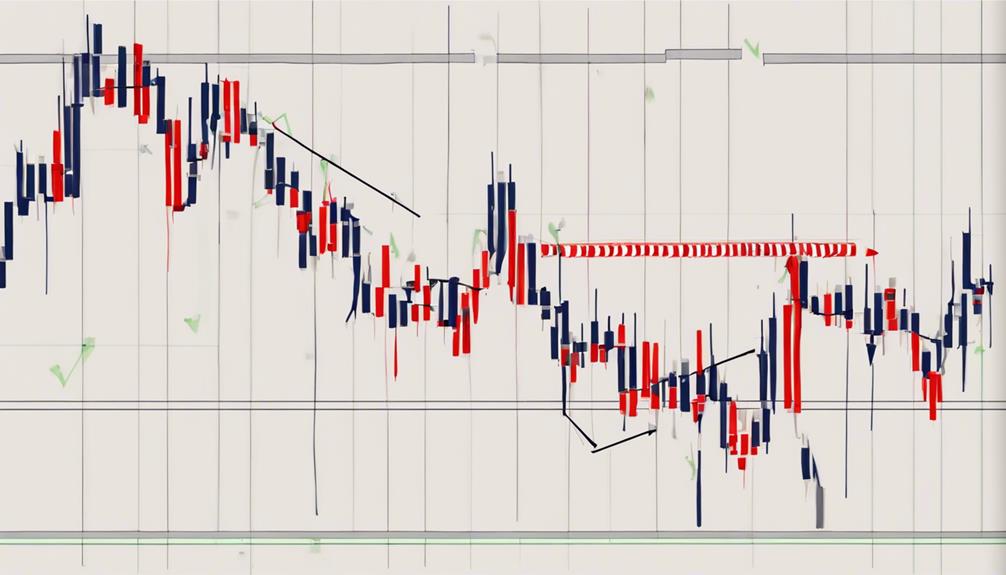
Using the Zig Zag indicator in Forex trading can assist traders in identifying optimal points for entering and exiting positions based on significant price swings. This tool filters out minor price movements to focus on crucial turning points in the market, aiding traders in confirming market trends and making strategic decisions. When utilizing Zig Zag for entry and exit points, traders can enhance trading precision and improve risk management.
Here are four key ways the Zig Zag indicator helps traders with entry and exit points:
- Highlighting Significant Price Swings: Zig Zag helps identify major price movements, indicating potential entry or exit points.
- Filtering Market Noise: By filtering out minor fluctuations, Zig Zag allows traders to focus on essential market turning points.
- Confirming Market Trends: Traders can use Zig Zag to confirm the direction of market trends, enabling better decision-making.
- Enhancing Trading Precision: Utilizing Zig Zag for entry and exit points can improve the accuracy of trades and overall trading precision.
Using Fibonacci With Zig Zag
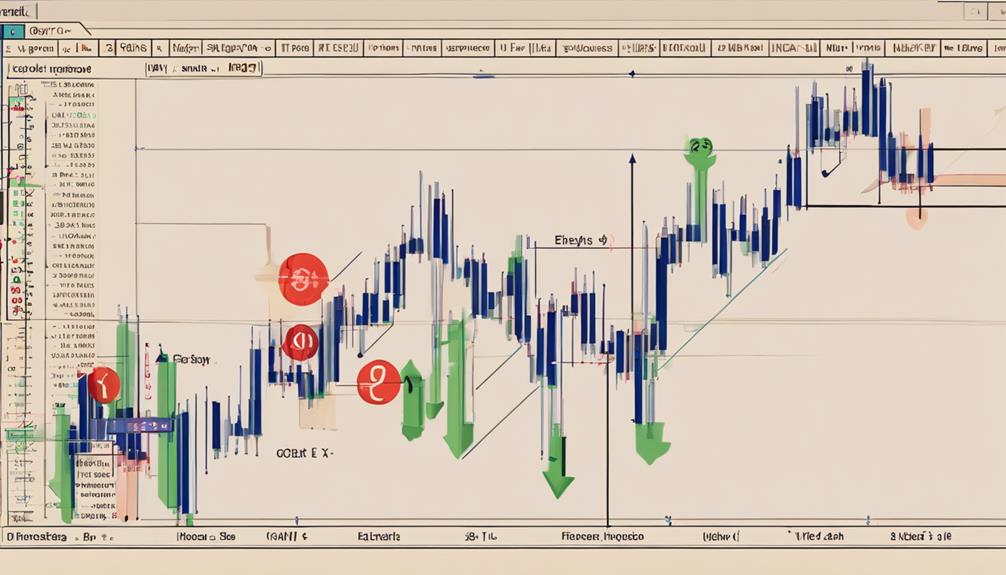
The integration of Fibonacci retracement levels with the Zig Zag indicator offers traders a powerful tool to enhance trend identification in the Forex market.
By seeking confluence between key Fibonacci levels and Zig Zag swing points, traders can pinpoint areas of potential price reversals with greater precision.
This strategic combination aids in refining entry and exit points, contributing to a more effective technical analysis approach for traders utilizing the Zig Zag indicator.
Fibonacci Retracement Levels
When integrating Fibonacci retracement levels with the Zig Zag indicator in forex trading, a trader can enhance their ability to pinpoint potential reversal points with increased accuracy.
- The Zig Zag indicator helps filter out market noise, highlighting significant swing highs and lows.
- Combining Fibonacci retracement levels with the Zig Zag indicator aids in identifying key support and resistance levels.
- Overlaying Fibonacci levels on Zig Zag patterns aligns trading decisions with technical indicators.
- This approach provides a structured method for spotting price retracements and extensions in the Forex market.
Enhancing Trend Identification
Incorporating Fibonacci retracement levels in conjunction with the Zig Zag indicator offers traders a powerful method for enhancing trend identification in the forex market. By combining the Fibonacci retracement tool with the Zig Zag indicator, traders can more accurately pinpoint potential reversal points within a trend.
Fibonacci retracement levels act as crucial support and resistance areas that complement the Zig Zag indicator's analysis of market trends. The confluence of these two tools enhances the confirmation of significant price levels and aids in formulating effective entry and exit strategies.
Utilizing Fibonacci levels alongside the Zig Zag indicator provides traders with a more precise and insightful approach to identifying key trend movements and potential reversal zones in the forex market.
Stop Loss and Take Profit With Zig Zag
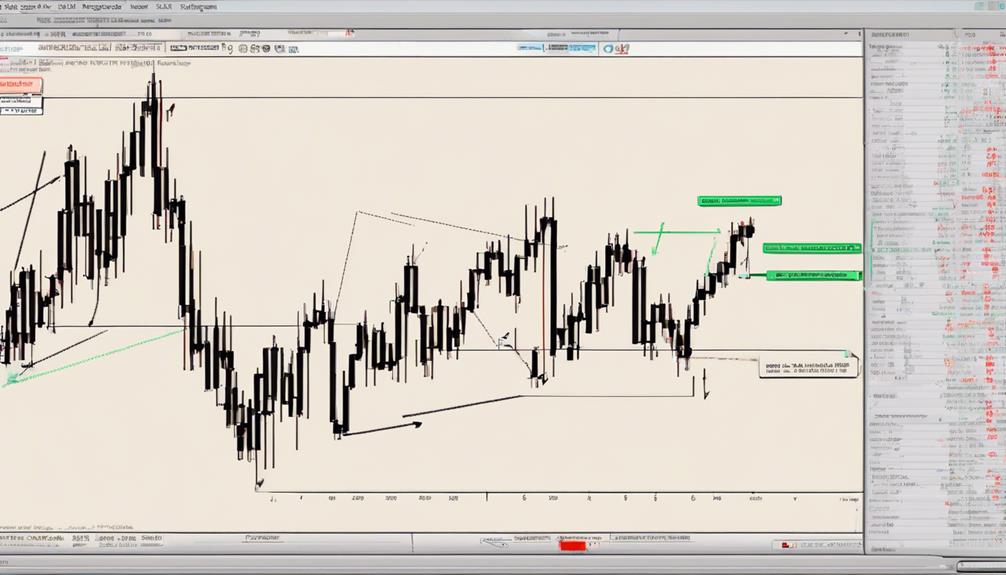
Utilizing the Zig Zag indicator for Forex trading involves strategically placing stop loss and take profit levels based on recent swing highs and lows. When setting these levels, traders aim to protect their capital from excessive losses while maximizing potential profits. Here are key points to consider when determining stop loss and take profit levels with the Zig Zag indicator:
- Stop Loss Placement: Place stop loss below the recent swing low for long positions or above the recent swing high for short positions.
- Take Profit Strategy: Identify key support or resistance levels based on Zig Zag patterns to determine take profit levels.
- Risk-Reward Ratio: Maintain a risk-reward ratio of at least 1:2 when setting stop loss and take profit levels.
- Dynamic Adjustments: Zig Zag can help traders adjust stop loss and take profit levels dynamically as market trends evolve, enhancing the adaptability of Forex trading strategies.
Common Mistakes to Avoid With Zig Zag
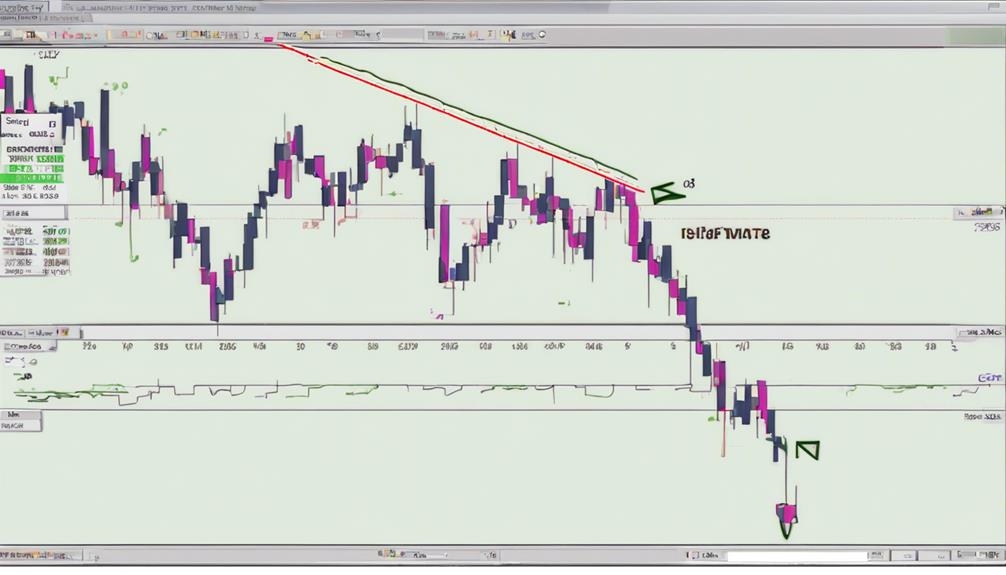
One critical aspect to consider when utilizing the Zig Zag indicator for Forex trading is to steer clear of common mistakes that could hinder its effectiveness. Firstly, avoid using the Zig Zag indicator in isolation for making trading decisions. It is best utilized in conjunction with other technical analysis tools to confirm signals and enhance precision.
Additionally, do not solely rely on the Zig Zag indicator for entry and exit points; always validate its signals through supplementary analysis. Setting the Zig Zag indicator threshold too low should also be avoided, as this may lead to an influx of signals, potentially resulting in false positives.
Furthermore, overlooking the broader market context while solely depending on Zig Zag signals for trading can limit its efficacy. Market conditions play a crucial role in the indicator's performance.
Lastly, never neglect the significance of incorporating robust risk management strategies when using the Zig Zag indicator. Effective risk management is essential for minimizing potential losses and ensuring long-term trading success.
Advanced Strategies With Zig Zag
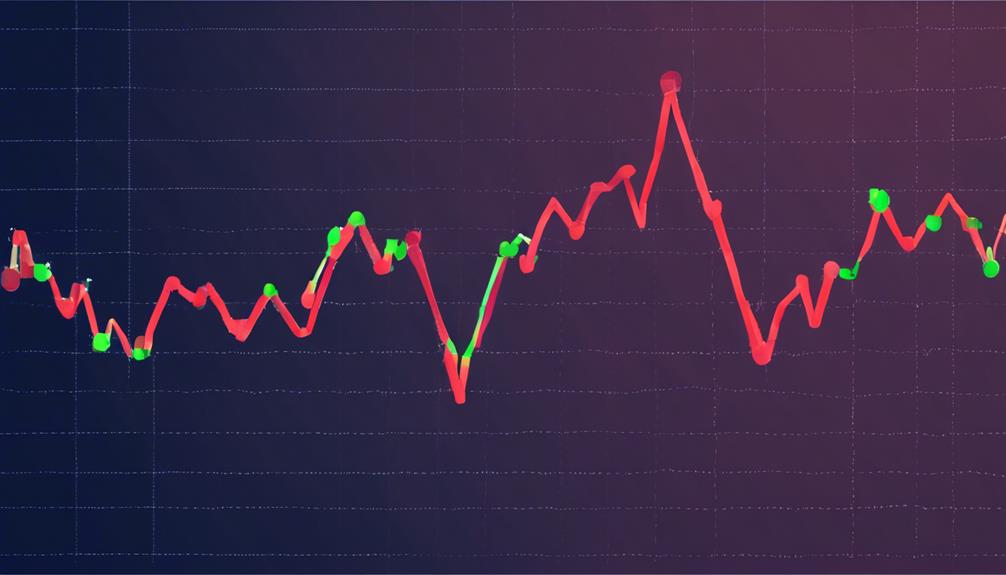
Advanced deployment of the Zig Zag indicator in Forex trading involves fine-tuning parameters such as Depth and Deviation to pinpoint precise trends with increased accuracy. When utilizing advanced strategies with the Zig Zag indicator, traders can enhance their analysis by incorporating Fibonacci retracement levels to predict price reversals more accurately.
Additionally, combining the Zig Zag indicator with other technical analysis tools like moving averages or RSI can provide a more comprehensive view of potential trade setups. Advanced users often customize the Zig Zag indicator to align with their trading style and timeframe preferences, optimizing its effectiveness.
To succeed in implementing advanced strategies with the Zig Zag indicator, traders must possess a deep understanding of market dynamics and the ability to interpret complex price movements effectively. By mastering the intricacies of this indicator and integrating it with other tools, traders can develop robust strategies to navigate the dynamic Forex market successfully.
Zig Zag Indicator Best Practices
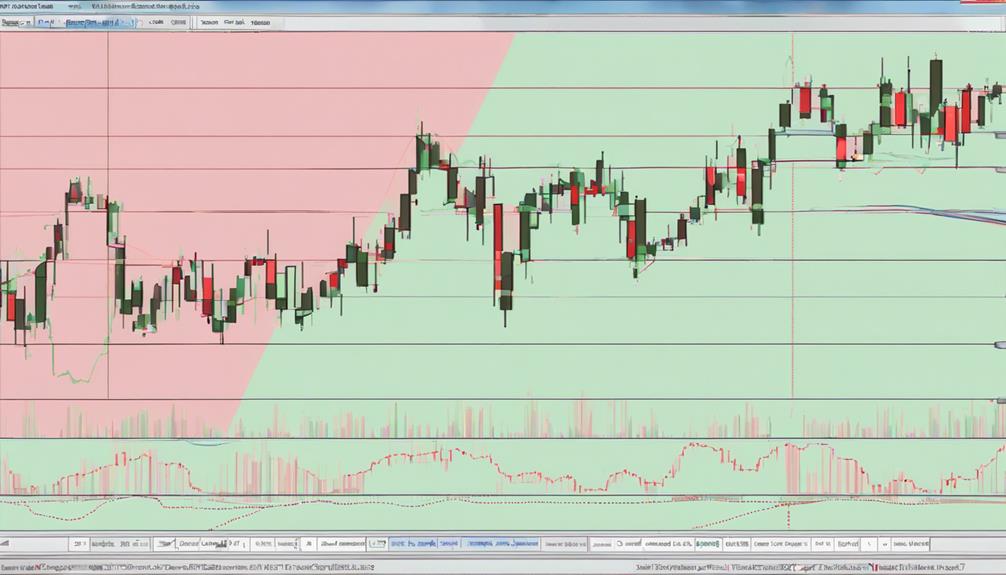
When optimizing the Zig Zag indicator for Forex trading, focusing on long-term trend reversals is paramount for maximizing its effectiveness in identifying reliable signals. Swing traders who use the Zig Zag indicator should prioritize capturing significant price trends rather than getting caught up in minor fluctuations.
By setting the indicator threshold between 8% and 15%, traders can adjust the sensitivity of the Zig Zag to suit their trading preferences. This customization can help filter out noise and highlight substantial price movements that align with the overall trend.
To enhance trading decisions, combining the Zig Zag indicator with volume indicators and Relative Strength Index (RSI) can offer further confirmation of potential trade opportunities. Traders must exercise caution and trade with money management principles in mind, as no indicator guarantees success on its own.
The Zig Zag indicator, when used judiciously in conjunction with other tools, can be a valuable asset in identifying and capitalizing on significant price trends in the Forex market.
Can the Zig Zag Indicator be Used for Forex Price Prediction?
Yes, you can simplify price prediction with zig zag. The Zig Zag Indicator helps traders identify support and resistance levels, as well as potential trend reversals. While it may not predict exact prices, it can be a useful tool for analyzing price movements and making informed trading decisions in the forex market.
What Are Some Simplified Strategies for Using the Zig Zag Indicator in Forex Trading?
When it comes to trading success with zig zag indicator, simplicity is key. Focus on identifying the market’s trend and utilize the indicator to spot potential trend reversals. Use the indicator to confirm the overall trend and wait for price to move in the direction of the trend before making a trade.
Frequently Asked Questions
What Is the Best Zigzag Indicator Setting?
For optimal performance, the best Zig Zag indicator setting typically involves a Depth of 12, Deviation of 5%, and Backstep of 3. These values can be adjusted to align with individual trading preferences, enhancing trend identification accuracy.
What Is the 5 3 1 Forex Strategy?
The 5 3 1 Forex strategy involves setting the Zig Zag indicator to Depth 5, Deviation 3%, and Backstep 1. This strategy helps traders filter market noise, identify key price levels, and make informed entry decisions in Forex trading.
What Is the Simplest Most Profitable Trading Strategy?
The simplest and most profitable trading strategy involves identifying key support and resistance levels to optimize entry and exit points. This approach, when combined with other technical tools, enhances trading accuracy and profitability.
Is Zigzag Indicator Accurate?
The Zigzag indicator's accuracy fluctuates based on specified settings, market conditions, and volatility levels. Traders can refine settings for better results. Combining Zigzag with other tools enhances trend identification. While not flawless, Zigzag aids trading decisions when paired with complementary indicators.
Conclusion
In conclusion, the Zig Zag Indicator is a powerful tool for identifying trend reversals in Forex trading. When used in conjunction with other technical analysis tools, it can enhance trend identification and trading effectiveness.
By setting parameters and avoiding common mistakes, traders can effectively pinpoint entry and exit points for potential profit. Incorporating the Zig Zag Indicator into a comprehensive trading approach can lead to successful trading strategies and improved decision-making.


